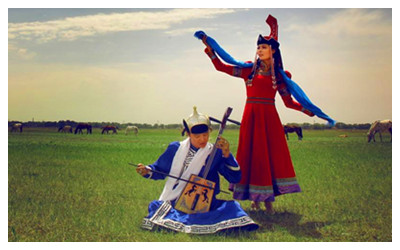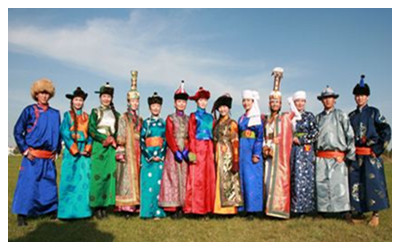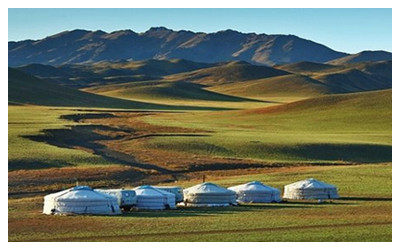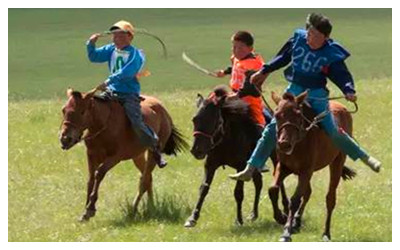Skype: neodalle-travel
Tel: +86 135 7447 2266
E-mail: sales@visitaroundchina.com

 Before the Mongolian people formed into the large ethnic group that it later so famously became, there had been many smaller ethnic groups in the region, such as the Xiongnu, Donghu, Xianbei, Rouran, Turkey, Huihu, Qidan, Shiwei-Daheng and others. Most historians believe that the earliest folk who identified themselves as being Mongols - that is, the people belonging to the set of ethnic characteristics that would later be identifed as being "Mongolian" - stem from the Donghu ethnic group. In any case, in the spring of CE 1206, a powerful Mongolian clan leader of the region, a certain Temüjin, called on all of the other clan leaders in the region to gather at a specific location on the Orkhon River for the purpose of holding an assembly - akurultai (the Altaic equivalent of the Afghan loya jirga) - to discuss the possibility of uniting their separate territories into one single unit. At this important assembly, two epochal events occurred: the Mongol empire was born and Temüjin was proclaimed it ruler, its Genghis Khan.
Before the Mongolian people formed into the large ethnic group that it later so famously became, there had been many smaller ethnic groups in the region, such as the Xiongnu, Donghu, Xianbei, Rouran, Turkey, Huihu, Qidan, Shiwei-Daheng and others. Most historians believe that the earliest folk who identified themselves as being Mongols - that is, the people belonging to the set of ethnic characteristics that would later be identifed as being "Mongolian" - stem from the Donghu ethnic group. In any case, in the spring of CE 1206, a powerful Mongolian clan leader of the region, a certain Temüjin, called on all of the other clan leaders in the region to gather at a specific location on the Orkhon River for the purpose of holding an assembly - akurultai (the Altaic equivalent of the Afghan loya jirga) - to discuss the possibility of uniting their separate territories into one single unit. At this important assembly, two epochal events occurred: the Mongol empire was born and Temüjin was proclaimed it ruler, its Genghis Khan.
During the course of the next half century, Genghis Khan and his immediate successors would conquer most of Asia and the European parts of Russia, and would extend their power into Southeast Asia and parts of central Europe - and they could easily have conquered all of Europe, believe historians, but chose not to pursue this option, for baffling reasons that will probably never be fully elucidated. The grandson of Genghis Khan, Kublai Khan, finally conquered China in 1279 and established the Yuan Dynasty (CE 1279-1368).
Internal rivalry within the Mongol ruling elite, combined with numerous uprisings in response to the harsh and arbitrary rule of the Mongols, weakened the Yuan grip on China, and in 1368 a revolt led to the establishment of the Han Chinese Ming Dynasty (CE 1368-1644), and the Mongols retreated to Mongolia, where they would continue to do battle with their neighbors to the south, as well as among themselves. Mongolia eventually re-unified, becoming a theocratic (Muslim) state in 1585, but would become a vassal state to China a hundred years later, in 1691, under the rule of the Manchus (the part of Mongolia that would later be designated as Inner Mongolia – see below – had already come under Manchu domination in 1636), who took advantage of a number of factors that had constantly dogged the Ming Dynasty: continued warring against the Mongolians, foreign incursions into China by Western powers, and endemic corruption.
In 1644 the Qing Dynasty (CE 1644-1911), the last dynasty of imperial China, was ushered in under the leadership of the Manchus, who would inherit the same existential problems mentioned above that had dogged the Ming Dynasty.
With China's independence from imperial, though not colonial, rule in 1911 (foreign powers had carved out portions of China during the Opium Wars of the Qing Dynasty, though the British would first relinquish Hong Kong in 1997 while the Portugese would first relinquish Maccao in 1999), the Republic of China was established in 1912, in which the southern part of Mongolia, which thereafter came to be known as Inner Mongolia ("Inner" Mongolia was separated from the rest of Mongolia, which thereafter came to be known as Outer Mongolia, by the Gobi desert), was incorporated into the new Chinese republic, a circumstance which - for good or for evil - probably reflected the actual "facts on the ground" of Inner Mongolia especially, which had been under strong Manchu influence since 1691 (but the new Chinese republic probably also feared a unified Mongolia on its doorstep, now that imperial Chinese control of Mongolia no longer existed). Inner Mongolia became the Inner Mongolia Autonomous Region under the People's Republic of China, which autonomous status it continues to enjoy today.
Lfie stye of Mongol
Mongol people in China are living on vast grasslands; therefore, stockbreeding played a major role in their development, together with agriculture, handicrafts, and other processing industries.
Food & Dining
Mongol people take milk and meat as their daily staple food and drink. They enjoy drinking the milk of sheep, horses, deer and camels. Kumiss, fermented out of horse milk, is a kind of distinctive wine with the function of driving out coldness and as well as strengthening the stomach. Tender, boiled mutton, 'Shouzhua Rou' in Chinese, is representative, too, of their traditional food. These people were so skilled in their cooking that they were able to cut the meat into pieces without chopsticks.
Dressing & Clothing
 The hat, the caftan ("deel"), the sash, and the stylish, upturned boots form the indispensible nucleus of the Mongolian's outdoor attire. In former times, the hat was a highly personal item of fur and silk, and though its design was primarily utilitarian (especially the everyday hat, or louz, whose four sides, or flaps, could be turned down for added warmth - for example, over the ears), it was typically adorned with whatever trinkets the owner valued, or with pearls or even precious stones, if one could afford them - indeed, the ornamentation on one's hat revealed one's status - and with long, colorful tassels that streamed in the wind.
The hat, the caftan ("deel"), the sash, and the stylish, upturned boots form the indispensible nucleus of the Mongolian's outdoor attire. In former times, the hat was a highly personal item of fur and silk, and though its design was primarily utilitarian (especially the everyday hat, or louz, whose four sides, or flaps, could be turned down for added warmth - for example, over the ears), it was typically adorned with whatever trinkets the owner valued, or with pearls or even precious stones, if one could afford them - indeed, the ornamentation on one's hat revealed one's status - and with long, colorful tassels that streamed in the wind.
Today, the Mongolian's hat is more often than not a mass-produced item, perhaps even imported, with the quality accordingly. The hat has always been the most special item of a Mongolian's attire. One does not leave one's hat lying about where it risks being crushed, but places it on a high perch precisely to avoid such mishaps. Such is the importance that has traditionally been attached to headdress in Mongolian culture that a hat must be worn when meeting or greeting non-family members, when entering a ger (though one may be invited to remove the hat once inside), or when in the street, where it is considered indecorous to go bareheaded.
The deel is perhaps the most practical article of clothing of a Mongolian man of the steppe. Besides being the main garment (heavy jackets and the like may serve as outer garments over the deel), the deel can serve as a makeshift tent, a blanket and a screen, or mask, to hide behind, and it's long sleeves can be rolled down as gloves to provide further protection against the sun, wind, or rain, etc. There are summer deel and winter deel, just as deel come in various lengths and in various materials, ranging from leather (skin with or without fur) to cloth. The skin may stem from the lamb, goat, wolf, fox, otter, marten, or from the snow weasel, to name the most common. Cloth deel are generally either of a mixture predominantly consisting of cotton, of rayon, or of pure silk.
The Mongolian's sash is another highly utilitarian item that serves a number of purposes, like all Mongolian attire. A woman's sash is shorter and folded more narrowly than a man's sash, and in some localities a woman ceases to wear a sash at all after she marries, wearing instead a tight-fitting silk vest over the deel, elaborately embroidered and sometimes studded with precious stones. A man's sash, which is generally cinched tightly at the waist, is much longer and is folded into a broad band that can serve as a corset, protecting the wearer's internal organs from excessive jostling while riding. It also serves as a place to stash the indispensible knife and to attach various accessory pouches.
In addition to serving as a place to stash a knife and to fasten pouches, the sash, given the characteristic manner in which a deel is cut, serves as the bottom of a "pouch" that is formed by the sash and the wrap-around portion of the deel above the sash, which offers a vent, or opening, on the wearer's right-hand side, similar to the hand-warmer "kangaroo" pocket on a sweater, but here, a single-vented pocket (a quick look at a Mongolian in a deel with the sash in place will illustrate this "pouch" better than a thousand words - search among the images above*).
Traditional Mongolian boots also serve several purposes related to life on the steppe: they reduce the incidence of snake and insect bite, and they reduce chafing during the many hours spent on horseback. The choice of boot type, or style, depends on the season. Traditional Mongolian boots are generally made of leather, though sometimes they are made of cloth. As Mongolian society develops and the division of labor intensifies, the old method of Mongolian boot-making may give way to more modern, mass-production methods, which itself may well dictate boot styles to a large extent, since the more complicated the method of production, the more expensive the end product.
House & Living
 With the emergence of the PRC in 1949, the Chinese government undertook to modernize life for the many ethnic minorities that make up China, including its Mongolian ethnic minority. Today, most Mongols live in modern apartment blocks in urban development centers, in much the same way that people live everywhere in the developed world. However, the Chinese government has become increasingly aware of the necessity of preserving the cultural heritage of the Mongolian people within its borders, including preserving vernacular architecture (i.e., the houses and shops of ordinary people), which, for the Mongols, consists primarily of the ger (called a yurt in Turkish, a related Altaic language), the characteristic domed round tent, which is the traditional dwelling of the Mongol. Many Mongols live in modern urban housing for a part of the year, but switch to the ger at other times of the year in order to tend to domestic animals (sheep, goats, etc.).
With the emergence of the PRC in 1949, the Chinese government undertook to modernize life for the many ethnic minorities that make up China, including its Mongolian ethnic minority. Today, most Mongols live in modern apartment blocks in urban development centers, in much the same way that people live everywhere in the developed world. However, the Chinese government has become increasingly aware of the necessity of preserving the cultural heritage of the Mongolian people within its borders, including preserving vernacular architecture (i.e., the houses and shops of ordinary people), which, for the Mongols, consists primarily of the ger (called a yurt in Turkish, a related Altaic language), the characteristic domed round tent, which is the traditional dwelling of the Mongol. Many Mongols live in modern urban housing for a part of the year, but switch to the ger at other times of the year in order to tend to domestic animals (sheep, goats, etc.).
 The grandest festival is the Nadam Fair for five to seven days during late August. Mongolian people, in new clothes, will gather from many areas. Many will participate in the exciting competitions of shooting, wrestling, and horse-riding.
The grandest festival is the Nadam Fair for five to seven days during late August. Mongolian people, in new clothes, will gather from many areas. Many will participate in the exciting competitions of shooting, wrestling, and horse-riding.
Naadam, short for Eriyn Gurvan Naadam ("Three Manly Games") means "Entertainment!" in the mind of the typical Mongolian. The Naadam Grassland Festival of Inner Mongolia Autonomous Region is China's Mongolian ethnic minority's most magnificent yearly entertainment event, combining the traditional "Three Manly Games" of Naadam – wrestling, horse racing, and archery – with cultural exhibits and even a livestock fair....More
 Ask Questions ?
Ask Questions ?